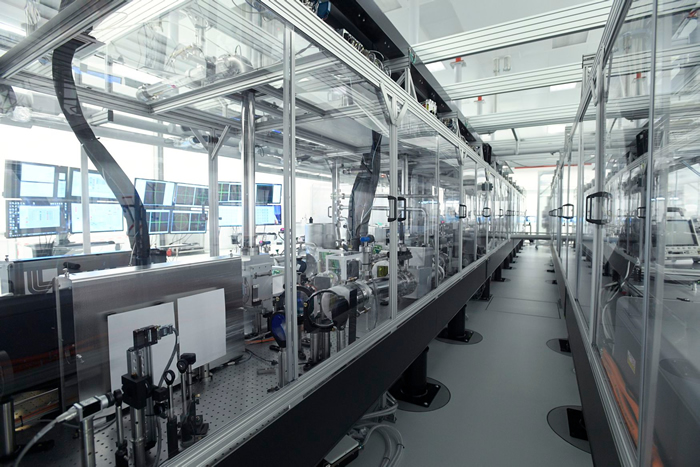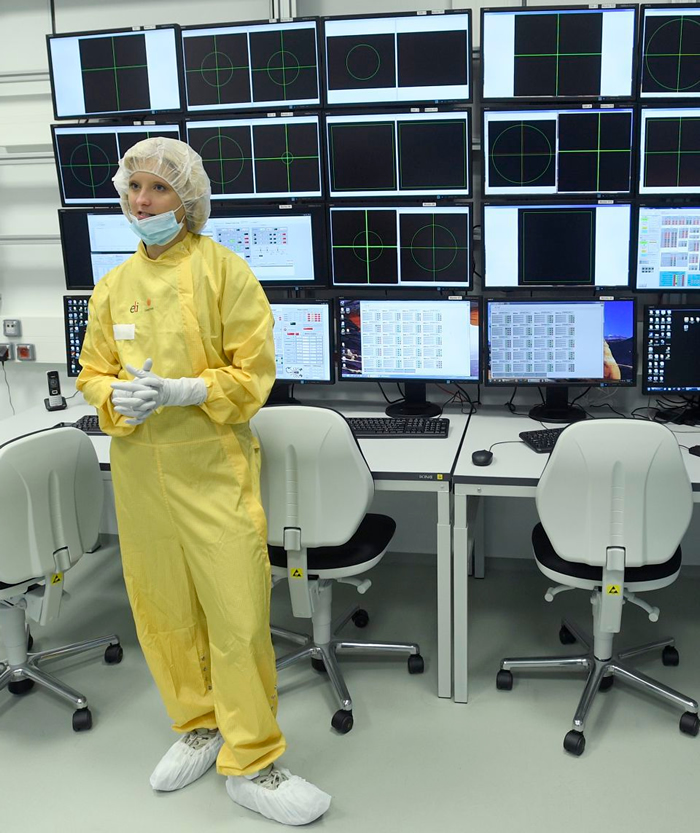Science & Technology - 2018
August
Video: What Goes into a NIF Shot?
HAPLS Wins Award for Technology Transfer
One of LLNL’s largest-ever technology transfer projects—the design, development, and construction of an advanced petawatt (quadrillion-watt) laser system known as HAPLS—has received a regional award for tech transfer from the Federal Laboratory Consortium (FLC).
HAPLS, the High-repetition-rate Advanced Petawatt Laser, is one of three Laboratory technologies, each supported by a Lab business development executive, to capture 2018 FLC awards.  Installed L3-HAPLS BeamlineThe L3-HAPLS beamline installed at the ELI Beamlines Research Center in the Czech Republic. Credit: ČTK
Installed L3-HAPLS BeamlineThe L3-HAPLS beamline installed at the ELI Beamlines Research Center in the Czech Republic. Credit: ČTK
The awards, two for outstanding commercialization success (including HAPLS) and one for outstanding technology development, were presented on Aug. 29 during the FLC’s three-day Far West/Mid-Continent regional meeting in Oklahoma City.
Started in 1974, the FLC assists the U.S. public and private sectors in using technologies developed by federal research labs. It is composed of more than 300 federal labs and research centers.
Lab researchers in the NIF & Photon Science Directorate designed and constructed the HAPLS laser system in only three years from concept to product under a $52 million agreement with the Czech Republic’s European Extreme Light Infrastructure (ELI). The laser was delivered to ELI in June 2017.
Unprecedented Precision
What makes HAPLS unique is its repetition rate and repeatability. It can fire up to 10 times per second and deliver in each of these pulses the peak power of 1 quadrillion watts—an order of magnitude faster than any other high-peak power laser in the world. HAPLS can deliver up to about 1.1 megajoules per hour of petawatt pulses.
This high repetition rate translates into photon flux that is important for commercial applications such as nondestructive evaluation of materials and laser fusion. It also allows exploration of new science with unprecedented precision, including time-resolved proton and x-ray radiography, laboratory astrophysics, and other basic science and medical applications for cancer treatment.
 Laser Systems Engineer Lucia Koubíková, a member of the ELI laser team, describes the ELI Beamlines control center. Credit: ČTK
Laser Systems Engineer Lucia Koubíková, a member of the ELI laser team, describes the ELI Beamlines control center. Credit: ČTK After an evaluation by an international peer review group, the petawatt laser—now known as L3-HAPLS—was declared fully integrated and operational at the ELI Beamlines Research Center in Dolní Břežany, Czech Republic, in June. The group assessed the laser performance and determined that all required performance parameters had been successfully met and that the system was ready for integration with the experimental systems as well as for first experiments.
Leading the HAPLS project allowed LLNL to draw on its decades of pioneering laser research and development and apply that expertise to advance new laser concepts important for its mission as a national laboratory. The collaboration extended beyond LLNL and ELI Beamlines; industry partnerships enabled the team to deliver a number of critical advances. For example, LLNL researchers worked with Lasertel Inc. to develop the world’s highest-peak-power laser diode arrays, representing total peak power of 3.2 megawatts, to power HAPLS.
Constantin Haefner, the program director for Advanced Photon Technologies at LLNL, notes that in the drive to achieve the far-reaching objectives of the HAPLS project, LLNL and its industrial partners jointly developed revolutionary components such as HILADS, a smart high-energy laser-diode pump system delivering pulses of about 1 kilojoule at 10 Hz; a gas-cooled, large-aperture titanium-doped sapphire amplifier; a dual chirped-pulse-amplification high-contrast short-pulse front end; an energetic gigashot laser pump source for pumping the short-pulse preamplifiers; and other advancements in optical coatings and control systems. Some of these breakthroughs are now on the market and have led to new business opportunities.
The LLNL-Czech partnership was made possible through an Agreement for Commercializing Technology (ACT)—a new technology-transfer mechanism piloted by the U.S. Department of Energy in June 2012.
This mechanism was conceived to help national laboratories form research partnerships using contractual terms better aligned with industry practice. Under an ACT, national lab contractors may take on financial risk that the U.S. government cannot assume.
In addition to Haefner, other key leaders in the technology transfer effort included Andy Bayramian, LLNL systems architect; Thomas Spinka, LLNL short-pulse commissioning manager; Bob Deri and Steve Telford, laser-diode pump system electrical engineers; Daniel Smith, controls engineer; Dan Mason, LLNL chief mechanical engineer; Jeff Horner, LLNL project manager; Craig Siders, senior scientist and commercial technology development leader; Genaro Mempin and David Dawes, business development executives from the Lab’s Innovation and Partnerships Office; Roman Hvezda, ELI project manager; and Bedřich Rus, ELI laser delivery manager.
Since 2007, LLNL has garnered 33 regional awards for technology transfer from the FLC. Click here for information on the Lab’s other 2018 FLC awards.
What Goes into a NIF Shot?
This new video produced by the Laboratory’s Lawrence Livermore Television Network (LLTN) reveals the anatomy of a NIF experiment—from the initial discussions of the experimental design to the fabrication of the target, the target’s installation in the Target Chamber, and the countdown in the Control Room:



